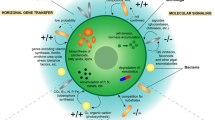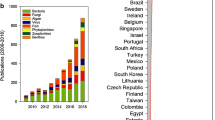Abstract
Freshwater molluscs have found strategic applications in public and veterinary health. Additionally, they have been used as bioindicator organisms towards environmental biomonitoring of polluted waters. The freshwater pulmonate, Physa acuta has been extensively studied as a potential biomarker in aquatic habitats with heavy metal, chemical, and microbial stressors. Lack of genomic resources is the bottleneck towards the study of candidate genes responsible for the unique adaptation of the mollusc to contaminated aquatic habitats. We have reported an EST survey of functionally relevant stress and defense related genes from P. acuta in our earlier study. In continuation of the same, we generated 1108 high-quality ESTs from a normalized cDNA library, pooled from the RNA isolated from the whole body tissue of CdCl2 exposed specimens of P. acuta. After clustering and assembly, we finally obtained 730 unique sequences representing 114 contigs and 616 singletons. Annotation of EST sequences revealed that 65.2, 62.8, and 35.9 % show significant homology to NCBI non-redundant database, Molluscs amino acid database, and NCBI KOG database, respectively. The functional characterization of the ESTs in Cd treated P. acuta group showed a greater proportion of signal transduction, cytoskeleton, and extracellular structure relevant genes compared with the control group. A large proportion of transcripts of cadmium treated P. acuta fell under the poorly characterized group of genes. These EST resources provide valuable information on Cd-specific transcript expression of P. acuta and could be utilized by scientists for developing new biomonitoring markers.

Similar content being viewed by others
References
Amiard-Triquet C (2009) Behavioral disturbances: the missing link between sub-organismal and supra-organismal responses to stress? Prospects based on aquatic research. Hum Ecol Risk Assess 15:87–110
Barry MJ (2011) Effects of copper, zinc and dragonfly kairomone on growth rate and induced morphology of Bufo arabicus tadpoles. Ecotoxicol Environ Saf 74:918–923
Bhattacharyya MH, Wilson AK, Rajan SS, Jonah M (2000) Biochemical pathways in cadmium toxicity. In: Zalups RK, Koropatnick J (eds) Molecular biology and toxicology of metals. Taylor and Francis, London, pp 34–74
Boyd RS (2010) Heavy metal pollutants and chemical ecology: exploring new frontiers. J Chem Ecol 36:46–58
Byzitter J, Lukowiak K, Karnik V, Dalesman S (2012) Acute combined exposure to heavy metals (Zn, Cd) blocks memory formation in a freshwater snail. Ecotoxicol 21:860–868
Connor KM, Gracey AY (2011) Circadian cycles are the dominant transcriptional rhythm in the intertidal mussel, Mytilus californianus. Proc Natl Acad Sci USA 108:16110–16115
Cui Y, McBride SJ, Boyd WA, Alper S, Freedman JH (2007) Toxicogenomic analysis of Caenorhabditis elegans reveals novel genes and pathways involved in the resistance to cadmium toxicity. Genome Biol 8:R122. doi:10.1186/gb-2007-8-6-r122
Ewing B, Green P (1998) Base-calling of automated sequencer traces using phred. II. Error probabilities. Genome Res 8:186–194
Ewing B, Hillier L, Wendl MC, Green P (1998) Base-calling of automated sequencer traces using phred. I. Accuracy assessment. Genome Res 8:175–185
Gagnaire B, Geffard O, Xuereb B, Margoum C, Garric J (2007) Cholinesterase activities as potential biomarkers: characterization in two freshwater snails, Potamopygus antipodarum (Mollusca, Hydrobiidae, Smith 1889) and Valvata piscinalis (Mollusca, Valvatidae, Muller 1774). Chemosphere 71:553–560
Guo Y, He H (2014) Identification and characterization of a goose-type lysozyme from sewage snail Physa acuta. Fish Shellfish Immunol 39:321–325
Hossain A, Aditya G (2013) Cadmium biosorption potential of shell dust of the freshwater invasive snail Physa acuta. J Environ Chem Eng 1:574–580
Jenny MJ, Ringwood AH, Lacy ER, Lewitus AJ, Kempton JW, Gross PS, Warr GW, Chapman RW (2002) Potential indicators of stress response identified by expressed sequence tag analysis of hemocytes and embryos from the American oyster, Crassostrea virginica. Mar Biotechnol 4:81–93
Jo YH, Baek MK, Kang SW, Lee JB, Byun IS, Choi SH, Chae SH, Kang JH, Han YS, Park HS, Lee YS (2009) Molecular cloning and expression pattern of Metallothionein gene from the left-handed shell, Physa acuta. Korean J Malacol 25:223–230
Kang SW, Hwang HJ, Park SY, Wang TH, Park EB, Lee TH, Hwang UW, Lee J-S, Park HS, Han YS, Lim CE, Kim S, Lee YS (2014) Mollusks sequence database: version II. Korean J Malacol 30:429–431
Karuthapandi M, Rao DV, Xavier Innocent B (2013) Freshwater mollusc Physa acuta (Gastropoda: Pulmonata) new distributional record from Andhra Pradesh, India. Int J Life Sci Educ Res 1:54–56
Knapen D, Reynders H, Bervoets L, Verheyen E, Blust R (2007) Metallothionein gene and protein expression as a biomarker for metal pollution in natural gudgeon populations. Aquat Toxicol 82:163–172
Koedrith P, Kim H, Weon JI, Seo YR (2013) Toxicogenomic approaches for understanding molecular mechanisms of heavy metal mutagenicity and carcinogenicity. Int J Hyg Environ Health 216:587–598
Lee JS, Raisuddin S (2008) Modulation of expression of oxidative stress genes of the intertidal copepod Tigriopus japonicus after exposure to environmental chemicals. In: Murakami Y, Nakayama K, Kitamura SI, Iwata H, Tanabe S (eds) Interdisciplinary studies on environmental chemistry-biological responses to chemical pollutants. TERRAPUB, Tokyo, pp 95–105
Lee K-W, Raisuddin S, Rhee J-S, Hwang D-S, Yu IT, Lee Y-M, Park HG, Lee J-S (2008) Expression of glutathione S-transferase (GST) genes in the marine copepod Tigriopus japonicus exposed to trace metals. Aquat Toxicol 89:158–166
Lee YS, Jo YH, Kim DS, Kim DW, Kim MY, Choi SH, Yon JO, Byun IS, Kang BR, Jeong KH, Park HS (2004) Construction of BLAST server for mollusks. Korean J Malacol 20:165–169
Lee YS, Lee S-G, Kang SW, Jeong JE, Baek MK, Choi S-H, Chae S-H, Jo YH, Han YS, Park H-S (2011) Expressed sequence tag analysis of Physa acuta: a freshwater pulmonate in Korea. J Shellfish Res 30:127–132
Lefcort H, Abbott DP, Cleary DA, Howell E, Keller NC, Smith MM (2004) Aquatic snails from mining sites have evolved to detect and avoid heavy metals. Arch Environ Contam Toxicol 46:478–484
Leung PTY, Ip JCH, Mak SST, Qiu JW, Lam PKS, Wong CKC, Chan LL, Leung KMY (2014) De novo transcriptome analysis of Perna viridis highlights tissue-specific patterns for environmental studies. BMC Genom 15:804. doi:10.1186/1471-2164-15-804
Lopez E, Arce C, Oset-Gasque MJ, Canadas S, Gonzalez MP (2006) Cadmium induces reactive oxygen species generation and lipid peroxidation in cortical neurons in culture. Free Rad Biol Med 40:940–951
Lopez-Doval JC, Poquet M, Munoz I (2014) Sublethal effects of the herbicide diuron on the freshwater snail Physella acuta. Limnetica 33:205–216
Luoma SN, Rainbow PS (2008) Metal contamination in aquatic environments: science and lateral management. Cambridge University Press, Cambridge
Milan M, Coppe A, Reinhardt R, Cancela LM, Leite RB, Saavedra C, Ciofi C, Chelazzi G, Patarnello T, Bortoluzzi S, Bargelloni L (2011) Transcriptome sequencing and microarray development for the Manila clam Ruditapes philippinarum: genomic tools for environmental monitoring. BMC Genome 12:234
Moolman L, Van Vuren JHJ, Wepener V (2007) Comparative studies on the uptake and effects of cadmium and zinc on the cellular energy allocation of two freshwater gastropods. Ecotoxicol Environ Saf 68:443–450
Pihan F, Vaufleury A (2000) The snail as a target organism for the evaluation of industrial waste dump contamination and the efficiency of its bioremediation. Ecotoxicol Environ Saf 46:137–147
Raisuddin S, Kwok KWH, Leung KMY, Schlenk D, Lee J-S (2007) The copepod Tigriopus: a promising marine model organism for ecotoxicology and environmental genomics. Aquat Toxicol 83:161–173
Regier N, Baerlocher L, Munsterkotter M, Farinelli L, Cosio C (2013) Analysis of the Elodea nuttallii transcriptome in response to mercury and cadmium pollution: development of sensitive tools for rapid ecotoxicological testing. Environ Sci Technol 47:8825–8834
Rice P, Longden I, Bleasby A (2000) Emboss: the European molecular biology open software suite. Trends Genet 16(276):277
Rittschof D, McClellan-Green P (2005) Molluscs as multidisciplinary models in environment toxicology. Mar Poll Bull 50:369–373
Rivetti C, Campos B, Faria M, Catala NC, Malik A, Munoz I, Tauler R, Soares AMVM, Osorio V, Perez S, Gorga M, Petrovic M, Mastroianni N, Lopez de Alda M, Masia A, Campo J, Pico Y, Guasc H, Barcelo D, Barata C (2015) Transcriptomic, biochemical and individual markers in transplanted Daphnia magna to characterize impacts in the field. Sci Total Environ 15:200–212
Sanchez-Arguello P, Fernandez C, Tarazona JV (2009) Assessing the effects of fluoxetine on Physa acuta (Gastropoda, Pulmonata) and Chironomous riparius (Insecta, Diptera) using a two-species water-sediment test. Sci Total Environ 407:1937–1946
Shuhaimi-Othman M, Nur-Amalina R, Nadzifah Y (2012) Toxicity of metals to a freshwater snail, Melanoides tuberculata. Sci World J. doi:10.1100/2012/125785
Tatusov RL, Fedorova ND, Jackson JD, Jacobs AR, Kiryutin B, Koonin EV, Krylov DM, Mazumder R, Mekhedov SL, Nikolskaya AN, Rao BS, Smirnov S, Sverdlov AV, Vasudevan S, Wolf YI, Yin JJ, Natale DA (2003) The COG database: an updated version includes eukaryotes. BMC Bioinf 4:41
Wadaan MAM (2007) The freshwater growing snail Physa acuta: a suitable bioindicator for testing cadmium toxicity. Saudi J Biol Sci 14:185–190
Yamada H, Koizumi S (2002) DNA Microarray analysis of human gene expression induced by a non-lethal dose of cadmium. Ind Health 40:159–166
Acknowledgments
This research was supported by Soonchunhyang University Research Funding (20130638) and the Basic Science Research Program through the National Research Foundation of Korea (NRF) funded by the Ministry of Science, ICT & Future Planning (NRF-2009-0073975).
Author information
Authors and Affiliations
Corresponding author
Ethics declarations
The tissue sampling for experiments was conducted in accordance with the International Guiding Principles for Biomedical Research involving animals (1985) (http://www.ncbi.nlm.nih.gov/books/NBK25438/).
Conflict of interest
The authors declare that they have no conflict of interest.
Additional information
Ji Eun Jeong, Bharat Bhusan Patnaik and Yong Seok Lee contributed equally.
Rights and permissions
About this article
Cite this article
Jeong, J.E., Patnaik, B.B., Kang, S.W. et al. Characterization of Physa acuta expressed sequence tags and transcript mining following cadmium exposure. Genes Genom 37, 1017–1025 (2015). https://doi.org/10.1007/s13258-015-0334-x
Received:
Accepted:
Published:
Issue Date:
DOI: https://doi.org/10.1007/s13258-015-0334-x




